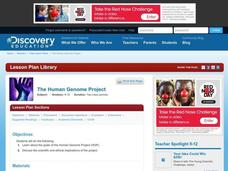Curated OER
28 Days - The Lunar Cycle time line
Third graders create a labeled lunar diagram time line illustrating the lunar cycle using Internet resources. An assigned date/month is given to each student, and an online Moon Phase calculator assists them with their drawings.
Curated OER
Picture This
Students create a descriptive paragraph conveying ideas utilizing a personal photograph as a prompt for their writing. This concept includes the writers emotions, personal issues, education, art and photography. They share insights to...
Curated OER
The American Revolution: Victory
Students discover the United States began to recognize the wounded as deserving of commendation toward the end of the American Revolution. They research the Purple Heart on two specific websites then design their own awards for other...
Curated OER
Human Genome Project
Students examine the goals of the Human Genome Project. They research issues of the project such as scientific, potential and ethical implications of the project. In addition, they create a presentation to present their findings.
Curated OER
North and South - Impact of the Abolitionist Movement
Young scholars examine history of slavery in United States, discuss abolitionists such as Frederick Douglass who worked to end slavery, listen to excerpts from Douglass' autobiography, and visit interactive Underground Railroad web site.
Curated OER
Literature: Watching Anna
Students view the PBS presentation of Leo Tolstoy's, "Anna Karenina." Prior and after each episode, they discuss plot and characterization and in one lesson, use adjectives to describe each of the main characters. Then, students create...
Curated OER
Tubularastic Roller Coaster
Students observe the effect of gravity on objects. They use tubing and other materials to simulate a roller caster. Afterward, they create a journal to write their observations and summaries.
Curated OER
Fossil Formation Fun
Students compare the three types of fossils: preserved organisms, mineral replacement fossils, and impression fossils. They create a model of amber,
sponge fossil, and make traces of fossil.
Curated OER
Walk the Line
Learners create constant speed versus motion graphs. They will perform linear regressions on their data to describe the graphs mathematically.
Curated OER
Adjective Games and Associated Worksheets
In this adjective games worksheet, students use adjective wheels, practice spelling adjectives, combine roots words to create an adjective, and explain how different objects using adjectives. Teachers are given detailed information on...
Curated OER
Bullying No Way Online Research
In this online bullying research worksheet, students access the given web site to find answers to 10 questions about individuality, the types of bullying, and ideas to be used to stop bullying.
Curated OER
The People's Design Award
Students analyze, critique, and evaluate information from various sources and learn about the design process. In this design instructional activity, students critique work submitted to People's Design Award and create a design of their...
Curated OER
Dealing with DNA Controversy
Pupils research controversial statements about biological applications and write a persuasive essay. In this biology lesson plan, students are assigned a controversial statement as a research topic, then they use this topic to create a...
Curated OER
Reader's Theater: Presenting Asian Folktales
Learners create and perform folktale plays. In this reader's theater and Asian literature lesson, students work in groups to rewrite Asian folktales into scripts and perform the folktales for their class in a Reader's Theater. Lesson...
Curated OER
Solar Matters II
Students research solar energy. In this solar energy lesson, students construct a KWL chart and research solar energy through various websites and related readings. Students complete a science journal page as an assessment.
Alabama Learning Exchange
The Birth of Rock(s) - Identifying Rock Types
Young scientists investigate types of rocks in this instructional activity. They collaborate to examine groups of rocks, make written descriptions of them, and use websites to help them identify the types of rocks they are.

















